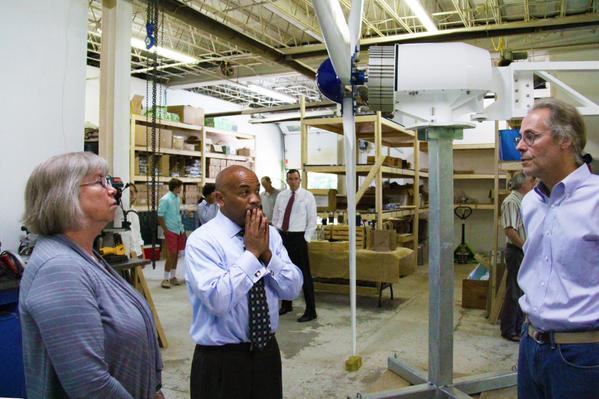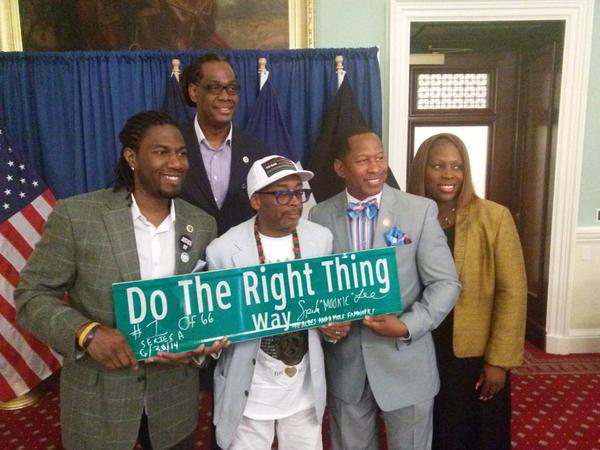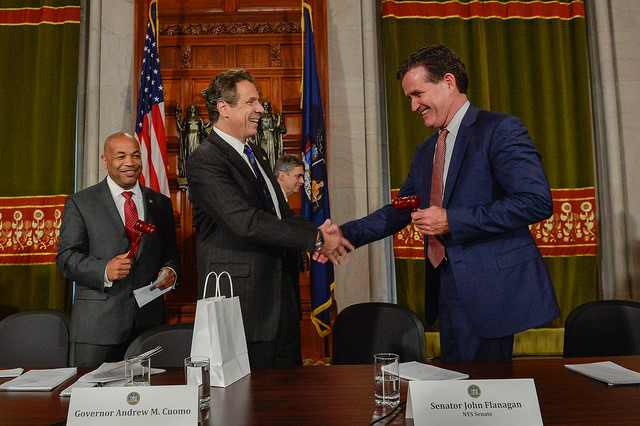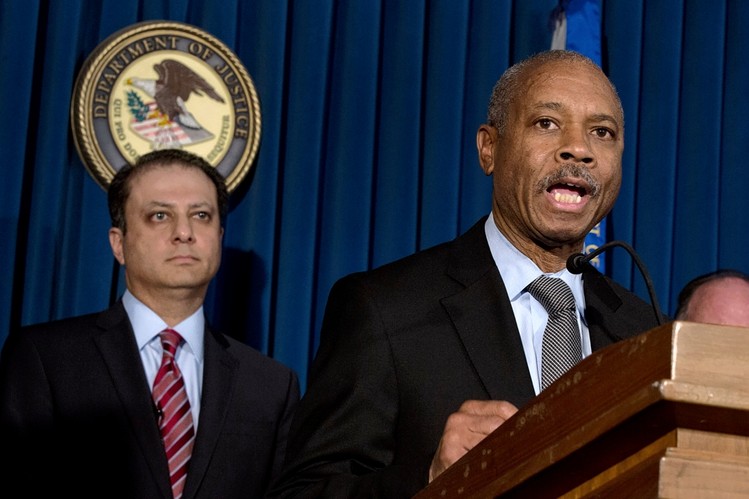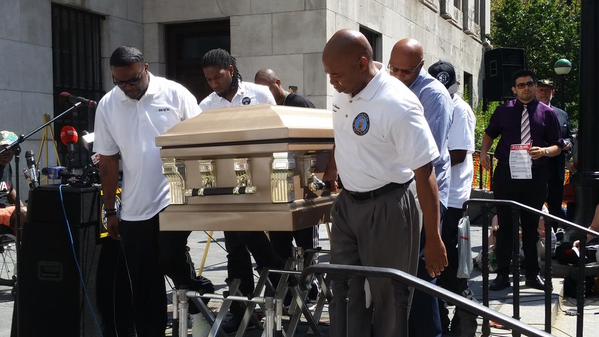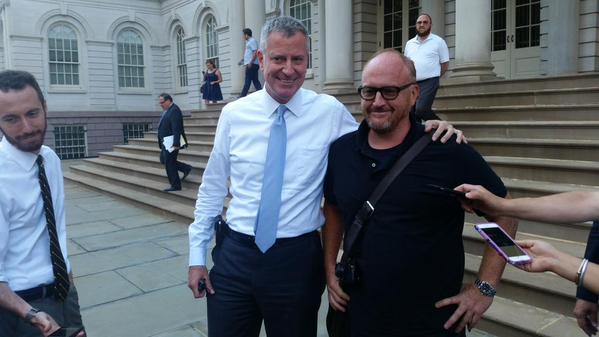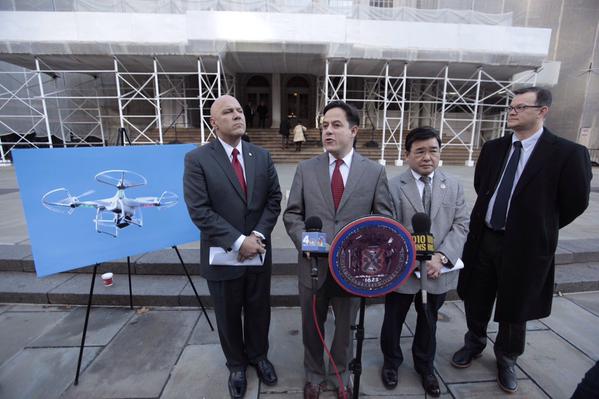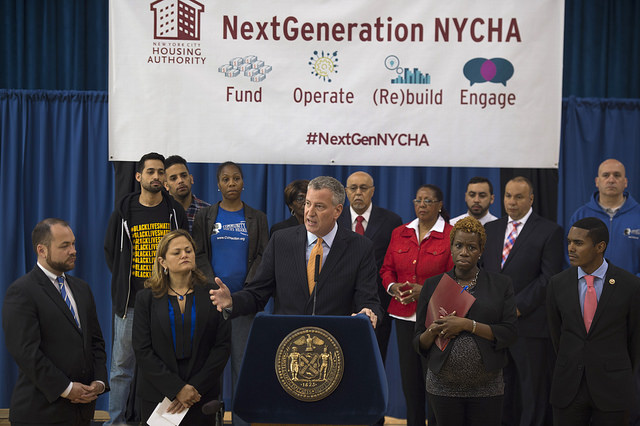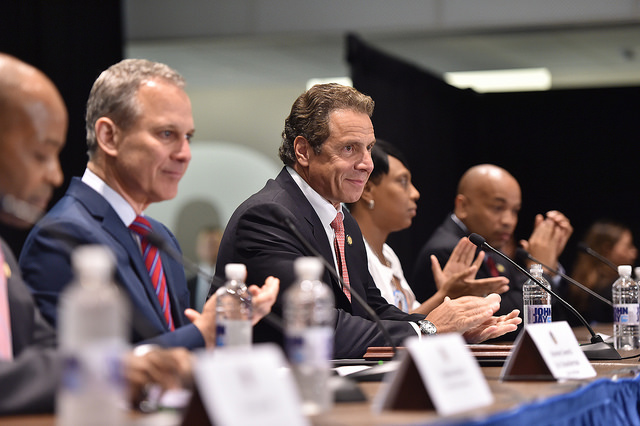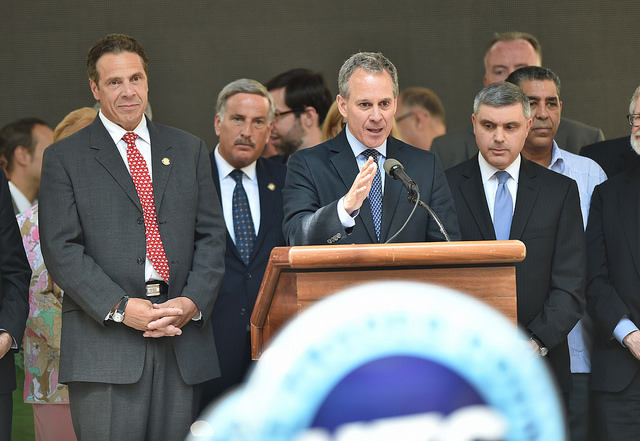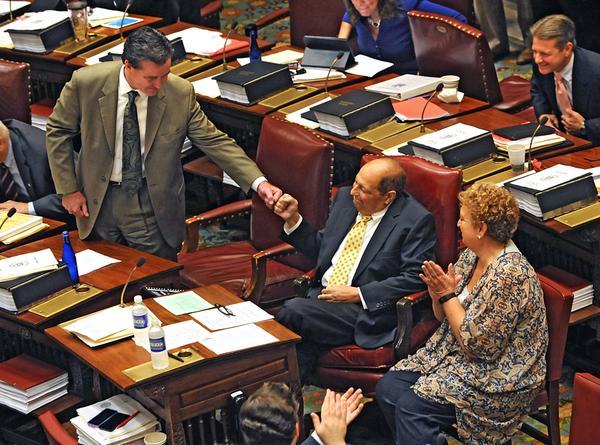
Rendering of proposed New York Wheel on Staten Island
There may be no other borough that has the local pride and identity felt by Staten Islanders. To be a Staten Islander often means to be of New York City and to be disconnected from New York City. It often means to know your family, but wonder if you were switched at birth.
Since New York City adopted its outer boroughs in 1898, Staten Island has always been the odd child out. Even for a city of islands, Staten Island seems, and is, far away. It is the enigma of New York City in virtually every aspect - at least most of it is, as the stereotypes of Staten Island sometimes belie its diversity.
Stand Island sits apart, though. Even the island accent is a bit more bombastic — more expressive, even — than the standard New York intonation. It’s important to have your voice stand out when you’re struggling to be heard.
The Staten Island existence has been, and continues to be, in some part dominated by its uneasy relationship with the larger city it is a part of, and the ongoing struggle its residents and elected representatives engage in to ensure that “the forgotten borough” gets its fair share.
Perhaps it’s fitting that Staten Island is the size of a key at the bottom left of the MTA subway map, which, of course, shows few lines cutting through the borough. It is a borough geographically far from the others, and population-wise, nowhere near a fifth of New York, with just under 500,000 residents in a city of over eight million. While much of the city is chasing rent, Staten Island has higher home ownership than any other borough, and its residents rely heavily on cars. For the most part, Islanders are big supporters of law enforcement, and it is a suburbia to many current and retired uniforms.
This is not to say that Staten Island is homogenous, of course. It is not.
The Island, aka Richmond County, looks more like America than the rest of New York City. Or, as Joe Borelli, one of only four Staten Islanders who serve in the 150-seat New York State Assembly, told Gotham Gazette, “New York looks at Staten Island weird, but it’s the rest of the country who’s looking at New York weird.”
It is the only borough with a clear white majority, at 77 percent of the population, compared to 12 percent African-American and 18 percent Latino, according to recent census figures. And the racial divide is stark: the North Shore is far more ethnically diverse and less wealthy than the South Shore and much of Mid-Island, with a reliance on public housing and apartment complexes to accommodate booming immigration populations. Staten Island has more registered Democrats, but most of its elected officials are Republican. This ruling conservatism makes it an outlier.
There’s been a longstanding feeling of disconnect, both figuratively and literally, between the residents of Staten Island and City Hall — pleas unheard, problems ignored. There is an ongoing sense on Staten Island that things simply aren’t fair.
It is the only borough without a full-service public hospital. Its transportation system, as many residents will tell you, is abysmal: besides the ferry, there is no direct route to Manhattan. Commuters are left with the more expensive buses that route through Brooklyn, and the always congested, pricey Verrazano Bridge, whose toll now stands at $5.50 each way (at the resident discount). The only intra-borough train in existence is the SI Rail, while no train operates from east to west. And the borough has been left with spots of land that are widely inaccessible by public transit.
The discontent is about funding, for sure, but not just about the money. It’s simply often part of what it means to be a Staten Islander - a sense of otherness, of not being understood or served by the public servants who are supposed to represent the *entire* city. But the question is: has the borough really been shortchanged? Under Mayor de Blasio or anyone else. That’s up for debate.
And Gotham Gazette is not the only entity looking for answers. Last week, the College of Staten Island announced that a $20,000 study will be conducted into whether or not the “forgotten borough” is truly forgotten. Pushed by City Council Member Steven Matteo and his predecessor as Minority Leader, Vincent Ignizio, the Council-funded research will essentially evaluate city services to see if Staten Island is getting its fair share. So, next time its delegates negotiate the city budget or other upcoming policy, the island will have a better idea of where it stands.
Well before that study gets underway, we set out to assess how much of its due Staten Island receives.
*****
As is the case with the current mayor, Bill de Blasio, Staten Island often votes against the city grain — it was the only borough de Blasio lost in his landslide 2013 victory over Republican Joe Lhota. In the City Council, Staten Island has three seats of the 51, which are allotted by population. Brooklyn has 16. “We have less representatives in the Council and Albany, which puts us at a disadvantage,” Borelli argued.
So, in late July, the small City Council delegation from Staten Island — Council Members Debi Rose, former Council Minority Leader Vincent Ignizio, and Steven Matteo — held a press conference alongside elected officials to announce big news for the borough: $30 million of Council funding in the Fiscal Year 2016 budget for capital and expense projects across the island.
The new infusion of cash would be pooled by Speaker Melissa Mark-Viverito’s office, the Staten Island council member delegation, and the Borough President’s office. Causes from libraries and school lunches to the Snug Harbor Cultural Center were getting a financial boost. A Council spokesperson also pointed out efforts in last year’s budget to increase ferry service and establish business improvement districts.
“This Council recognizes the important contributions of Staten Island and is thrilled to invest back into the borough in order to strengthen New York City as a whole,” Speaker Melissa Mark-Viverito noted.
“I thank Speaker Melissa Mark-Viverito and my colleagues in the Staten Island delegation for being partners in crafting a budget that responds to the real needs of Staten Islanders,” Council Member Rose added. Rose is the lone Democrat representing Staten Island in the Council, she is African-American and hails from the North Shore.
In the grand scheme of things, though, the $30 million jackpot is due more nuanced analysis. The new city budget includes a total of $78.6 billion for expenses. Then there’s $13.9 billion for capital projects across the city. Much of the full picture of what Staten Island receives is buried deep in those amounts, through mayoral agencies and city operations. This fogs up how the $30 million factors into a larger total, and what it means on the local level.
Take, for example, the funds for the borough presidents. James Oddo, Staten Island borough president and former member of the City Council, received the smallest BP allotment, $4.2 million, while Eric Adams, of Brooklyn, has $5.8 million to work with. Yet, per capita, Oddo has more money than any other BP. Adams has $5.8 million to spend on 2.6 million people, about five times the population of its somewhat distant neighbor.
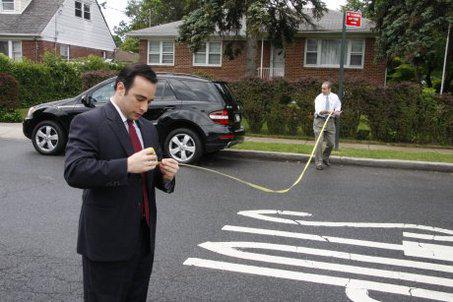
(former SI Council Members Ignizio, foreground, & Oddo)
Generally, it’s quite difficult to break the city budget down borough-by-borough, so much so that the College of Staten Island needs a well-resourced study to get to the bottom of this. You cannot flip open city budget documents to see a full accounting of what resources are devoted to each borough - it’s just not so easy to decipher how much of FDNY or Department of Health expenses are going to serve Staten Islanders, though estimates are surely possible.
Still, there’s the concept of insurance, that as part of the larger city, Staten Islanders can believe that there are virtually unlimited resources available were they to need them. Though, one need not look further than Superstorm Sandy to see the complicated nature of such a point.
There are many complicating factors to really trying to suss out how the city allocates resources.
“Let’s say a nonprofit agency based in Manhattan provides some of its services in the Bronx. The value of the contract for the work in the Bronx would show up in the Manhattan district where the agency is located,” Doug Turetsky, a spokesperson for the Independent Budget Office, told Gotham Gazette. “Another problem with these statements, or assigning dollars to a particular location, comes up with NYPD. An officer may be assigned to a particular precinct and that’s where he or she gets paid from, but on any given day that officer may be working in any part of the city.”
Turetsky was referring to what are known as District Resource Statements, which are provided by the Office of Management and Budget. These show analyses of the funds dedicated to the districts in every borough by each agency - but, as Turetsky explained, they don’t necessarily give the full picture of what Staten Island is getting, or, perhaps, not getting from the city.
Instead, Turetsky pointed to Community Board Geographic Reports, which are also OMB documents. This is a fuller borough-by-borough breakdown of the major agencies in the city (e.g. Parks and Recreation, Sanitation, NYPD). So, to get an idea of how Staten Island stacks up, looking at an agency like Parks and Recreation can be helpful.
According to the latest Community Board Geographic Report, for FY 2016, which began July 1, the funds for Staten Island borough-wide parks and rec total upwards of $1.8 million, with 27 full-time park employee positions. Queens, meanwhile, has $3.9 million allocated for borough-wide recreation, with 47 full-time positions. Around the same budget increase is set to occur next year for both boroughs: $55,000.
Staten Island parks see about half the funding of Queens’ while the borough has more park land, but many fewer residents. The island boasts the title of “Greenest Borough,” having 113 city parks, which, with state parks included, constitute a third of the island’s land mass, 12,400 acres in total. Queens has more parks, but covering fewer total acres: 284 parks, 7,000 acres. Queens, though, has 2.3 million residents, while Staten Island has just over 500,000.
It is no surprise that in every category for the Department of Sanitation, meanwhile, Staten Island ranks lowest out of the boroughs — less people, less garbage.
That’s the main obstacle in comparing Staten Island, in general, with the rest of the city: the demands are completely different. Brooklyn, for comparison, serves nearly 300,000 students in its public schools, while Staten Island has 60,000 students. Speaking with Joseph Viteritti, the chair of the Urban Affairs and Planning Department at CUNY Hunter, about this, Gotham Gazette asked him how to sort through this reality and analyze any discrepancies. “It’s very hard to answer that,” he responded. “You can’t do a straight budget analysis, because the budget is driven by demand.”
And it’s not all about population, of course. Yes, Staten Island police districts may have smaller budgets, but if areas in Brooklyn have higher concentrations of violent crime, then it makes sense that Brooklyn precincts receive a bigger piece of the pie. The same applies to schools, sanitation, parks, and so on. Think about Manhattan, Viteritti said. Even with the smallest land mass of the five boroughs, it is home to Wall Street, countless skyscrapers, Central Park, and 1.6 million people; not to mention the hordes upon hordes of tourists.
“Of course Manhattan gets more money from the city [than Staten Island],” he explained. “How can you even compare the two?”
*****
Joe Borelli, the Assembly member set to soon replace Ignizio in the City Council, says Staten Island’s blues arise from its uniqueness. He says the problems faced by residents are unlike those anywhere else in New York. “Since as far back as the American Revolution,” Borelli muses, “Station Island was different, and disconnected.”
And though there are sections of Queens and other boroughs that resemble large swaths of Staten Island, there’s nowhere in the city with the combination of characteristics of the island, including its remoteness, limited public transportation, and more.
As a result of “the failures of urban liberalism” in the 1960s and 1970s, Borelli argues, his home island served as a refuge for white flight as crime skyrocketed elsewhere. This is why on the island, “everyone you know is related to a cop,” Borelli added. Yet, after Manhattan and other parts of the city regained social stability, many of the developments achieved over the past decade-plus have failed to make it across the Verrazano.
For example, the ferries that now ride up and down the East River, servicing the re-emergence of neighborhoods like Williamsburg and Long Island City. Albeit suspended until 2017, even Rockaway Beach, at the far southeast corner of Queens, had some sort of ferry service (in addition to the A train). Residents on the South Shore of Staten Island, on the other hand, are still waiting to be picked up.
Then there’s bikes. While Mayor Michael Bloomberg peppered the city with bike lanes and pedestrian plazas throughout the 2000s, Staten Island watched from the sidelines: the borough is more car-dependent than any other, with a far distance between the North and South shores. Hylan Boulevard, which is arguably the busiest thoroughfare in the whole borough, has rows of perpetually empty bike racks, which the city spent $60,000 to build, because a solid portion of the avenue has no lane dedicated to cyclists.
Whether Staten Islanders wanted bike racks—or lanes, for that matter—is up for debate. But the situation, Borelli explained, demonstrates this “general distaste” of residents towards the city’s larger urban planning ideas, of which they’ve been largely left out of. It is this uneven growth that has driven Borelli’s current (and unopposed) campaign to fill the empty seat left by Ignizio, who recently became the CEO of Catholic Charities on Staten Island. "Somebody has to speak for the millions of outer-borough, middle class homeowners that are lately placed on the back burner of city policy,” Borelli told DNAinfo, referring to more than just Staten Island woes.
When asked about the stark differences — population, size, demand — between Staten Island and the other boroughs, Borelli said that, yes, those things are true, but shouldn’t be the reasoning behind neglect. He then listed conundrums that could happen few places in the city but Staten Island. Parks built without sidewalks leading to them. Bike lanes delayed because of too much brush blocking them. Nearly $5 million spent on replacing trees.
“We have a lot of resources, but they’re left vacant or without funding,” Borelli argued. “We have more parkland than any other borough, and somehow have less of the Parks budget than everyone else. Where else can you ride an ATV in the city?”
“Find me a property anywhere else where the city builds a park but doesn’t put sidewalks in,” he continued. “It just doesn’t make any sense.”
This frustration, as expressed by Borelli, is part of the Staten Island id. In 1993, it came to a boiling point when Staten Island attempted to secede from New York City. The referendum effort, led by State Senator John Marchi, was, of course, a culmination of built-up emotions, but the immediate catalyst was the approval of a new City Charter in 1989, which did away with the Board of Estimate. Instead of having one vote of five, like every other borough, Staten Island now had just three City Council members to represent its interests across the Narrows. The borough arose in protest.
At the time, Joe Viteritti was the staff director of a commission that looked into the economic self-sustainability of Staten Island, or if an island with the population of a small city could manage alone without the help of sister boroughs and City Hall. The studies showed that it was feasible, Viteritto says, but his team also found that, in 1993, the cost of Staten Island to the city outpaced the revenue it generated by about $200 million. In other words, the city was putting more into Staten Island than it was receiving.
“These analyses point to the surprising conclusion that separation of Staten Island from New York would actually provide budget relief for the city,” he wrote then, in City Journal. “From a strictly economic perspective, the other four boroughs would come out ahead.”
This didn’t convince either Mayor Ed Koch or Mayor David Dinkins, both of whom strongly opposed the referendum. When Governor Mario Cuomo let the legislation proceed in Albany, Koch said the Democratic leader was “plunging a dagger into the city’s heart.” But it wasn’t up to him.
“Honestly, the only reason secession didn’t go through is that the legislation needed approval in the State Assembly, and it didn’t get it,” Viteritti told Gotham Gazette. “Cuomo, and then Pataki, were ready to sign it. [Former Assembly Speaker from Manhattan] Sheldon Silver bears sole responsibility for why Staten Island is not its own independent city right now.”
Now, over twenty years later, Viteritti doesn’t know if things are the same on Staten Island. The most immediate demands of the secession movement were met, and, in many ways, that’s why everyone Gotham Gazette spoke with for this article said Rudy Giuliani is still the most popular mayor on the island, by far.
Giuliani, a Republican, had a 1994 platform aimed at addressing the island’s two main grievances: making the Staten Island ferry free and closing the Fresh Kills dump (both were eventually accomplished). “To think, what was more symbolic to Staten Islanders than a place where the city can leave all of its garbage?” Doug Muzzio quipped.
At the time, Muzzio, a political scientist at CUNY Baruch and longtime city expert, was tasked with polling Staten Island residents. He said a “victim narrative” existed, in which residents felt their input surpassed the output (later found to be untrue) and, in return, they got the city’s garbage. While their transportation issues are “legitimate” reasons to be angry, Muzzio added, “Staten Islanders have always thought they were forgotten, and if they did get city services, they were ill-timed,” he said. This is part of the island’s “mythology” - too little, too late.
Yet, to Muzzio, Giuliani fit the Staten Island mold. His last name sounded like it was cut from the borough’s fabric. He was close with the renowned Borough President then, Guy Molinari. He was incredibly pro-NYPD, and he was a Republican. Staten Islanders still reminisce about the Giuliani days as a time when the island was truly a part of the city. In a recent tweet, James Oddo, the current BP, named the Giuliani Years as one of the few times in its history when “Staten Island was treated better than fairly.”
The same can almost be said about Bloomberg. Once again, a Republican, if only in his early mayoral years, and very close with the law enforcement base. To Staten Islanders, Bloomberg’s reign was praised for lower crime rates, much-needed rezoning and development, and finally, a focus on fixing their vast parkland. His property tax hike wasn’t received well, but, like with the rest of New Yorkers, maybe it will be down the line.
"I think his legacy is not fully baked,” now former Council Member Ignizio said when Bloomberg left office. “I think coming from Rudy Giuliani, who was wildly popular on Staten Island...following that act was tough.”
More controversially, Bloomberg was mayor during Superstorm Sandy, a storm that devastated Staten Island, perhaps more so than any other borough. It left millions of dollars worth of damages, and still, to this day, has residents rebuilding their homes. Bloomberg’s attention to the disaster was received well, but his funding program — Build It Back — was not. The initiative, which was meant to siphon federal funds to those not insured, hadn’t issued a single check or broke ground on any related construction programs when he left office.
It was an utter failure in Staten Islanders’ eyes. And one that was saved by an unlikely, if quite unpopular, new figure who Islanders did not want elected and are still coming to terms with.
*****
There were all the ingredients for Staten Island scorn: a persecuted policeman, a progressive mayor the borough didn’t vote for, and a publicly drawn-out war that put the hometown base and new city leader on opposite sides. Not to mention that it happened just minutes from the Staten Island Ferry Terminal, and for all the world to see. The death of Eric Garner at the hands of Police Officer Daniel Pantaleo set off what had already been a begrudged populace. Within a year of his mayoralty, de Blasio had lost any goodwill many Staten Islanders had extended him, largely because of his comments in the aftermath of the grand jury’s decision not to indict Pantaleo.
Since then, his administration has made efforts to make it clear that City Hall does care about the mid-Island and South Shore constituency, with more visits, more funds for extensive capital projects, and a continued overhaul of Build it Back that finally has the program up and running - though many still find the pace too slow. Even with a 19 percent approval rating amongst Islanders, de Blasio seems set on establishing some island credentials, even against all odds. A progressive Democrat, from Brooklyn; at least he has the Italian last name.
"Mayor de Blasio has invested nearly $5 million a year to deliver 24/7 half-hour Staten Island ferry service, added over $240 million to improve road conditions, brought faster [snow] plowing to Staten Island residential streets, and improved the Build it Back program so residents are finally receiving checks and rebuilding their homes,” Monica Klein, a deputy press secretary for de Blasio, said in a statement to Gotham Gazette, “showing time and again that he is committed to improving the lives of Staten Islanders and giving the borough the attention it deserves.”
For the announcement on the repaving efforts, de Blasio made a trip to Staten Island after mounting criticism that he had zigzagged the country while spending little time in the “forgotten borough.” But praise was in the air from Staten Island officials. “Mayor de Blasio heard our pleas for help and delivered, and we are thankful for his commitment to improving our roads,” BP Oddo said, alongside the mayor, and a large "pave baby pave" sign from the borough president's office.

(via BP Oddo)
Still, many car-owning Islanders happy about new investments in roads may continue to point to de Blasio’s handling of the Eric Garner saga and a perceived lack of support for the NYPD. They are likely to pin any upticks in crime or perceived quality-of-life issues to the mayor’s legacy; a sentiment that is true across the city, but most acute on Staten Island. But regardless of what happens between the mayor and Islanders, there are strong forces at work that could drastically change just about everything on and about the island.
In April, the New York Times beat the gentrification drum with a headline that read, “Staten Island’s Turning Point?” The writer, C.J. Hughes, pointed out major developments that will mark the island coast in the near future: the New York Wheel (a massive London-Eye-esque ferris wheel), Empire Outlets (a huge mall complex), and numerous stores, coffee shops, and breweries. Not to mention a condo complex called Lighthouse Point and another called URL Staten Island, which, along with the Wheel and outlets, have been deemed the “core four” by The Real Deal, a development-focused publication.
While some are excited and see jobs afoot, others are skeptical. One resident remarked, “I like the small-town vibe, and I don’t mind that there’s a little bit of grit.”
Linda Baran, the director of the Staten Island Chamber of Commerce, says that the impending development is a conversation that the borough has yet to have. What will it do if thousands of New Yorkers start to move in, once again escaping the mainland, this time because of high rents, not crime? The spike in prices is something that “resonates through every conversation,” she said. Is Staten Island really ready for that?
“There is no dialogue about how the borough should receive the people coming in,” Baran told Gotham Gazette. “Now the idea is to bring new businesses here so people don’t have to leave.”
Baran argued that development could solve one of the main issues the island faces, and has always faced: vacancy. The shore, she said, is lined with empty industrial lots, which are not only a blight on the islandscape, but bad for business. She’s hoping that development will bring more attention to major borough-wide concerns, like infrastructure and healthcare, as it has in Brooklyn and Queens.
She added that the de Blasio administration has done a fine job of cutting red tape for small businesses, but other City Council-backed measures, like paid sick leave and ‘ban the box’ legislation disallowing background checks, are “good initiatives,” but have left Staten Island owners weary of City Hall intrusion. “I think the city has talked about fixing the business community here,” she told me. “But the businesses aren’t seeing that just yet.”
Still, Baran touched upon what could be a new chapter in the Staten Island mystique. After feeling forgotten for decades, this could be the future the island has longed for; one where it is on an equal playing field, both economically and culturally, with its borough brethren. There is a fear — or irony — that the borough could be on its way to getting more than it bargained for, with high-rise condos and public attractions threatening the Staten Island way of life, causing more traffic. Be careful what you ask for, some seem to be saying.
“We were always used to being last on the totem pole,” Baran said. “We were an escape for everyone. And now, the boroughs are saturated, and growth is a good thing.”
She paused, then said, “Things are changing.”
***
John Surico is a freelance metro reporter. His reporting has appeared in the New York Times, the Wall Street Journal, and here, for Gotham Gazette. He lives in Queens. Find him on Twitter @JohnSurico
@GothamGazette
